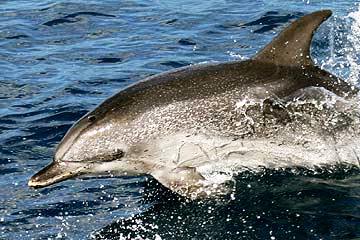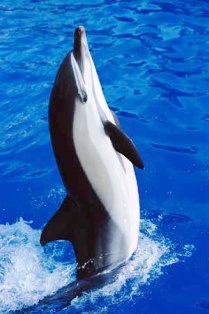Discover Florida Nature
It's time to explore the natural Florida


|
|
|
|
|
|
Several dolphin species occur in Florida costal waters. Dolphins
cooperate in many ways, some species more than others. As a group they
may guard against predation by sharks or support a sick or injured
community member in the water by keeping it afloat. A few dolphins
sometimes use the lengths of their bodies to encircle and pen a school
of fish in shallow water, like horses rounding up yearlings, in order to
feed. It is against federal law to feed or harass wild dolphins.
Swimming with or feeding dolphins can be dangerous for both human and
dolphin and should not be attempted. Dolphins are often heard clicking. Contrary to popular thought, clicking is likely not communication, but rather the sonar system dolphins use for navigation, food-finding and avoidance of predators. Clicks are one of three classes of sounds dolphins produce, in addition to squawks (whose purpose is unknown, although these sounds are made while dolphins are socializing), and pure tones, one of which is known as that dolphin's "signature whistle."  Atlantic
Spotted Dolphin-Atlantic spotted dolphins are found in the
tropical and subtropical waters of the Atlantic Ocean, including the
Florida coastline. They can also be found in the Indian Ocean and in
some parts of the Pacific. The upper body of the Atlantic spotted
dolphin is a dark gray color. This fades to a medium gray on the sides
and a light ventral surface. They have a chunky beak with a spot of
white on the end. The name of the Atlantic spotted dolphin comes from
the spots that develop as the dolphin ages. The older the dolphin, the
more spots. Adult females tend to be larger than adult males. The length
of the Atlantic Spotted Dolphin averages about 7 feet and it weighs an
average of 220 pounds. The typical family group of the Atlantic spotted
dolphin can consist of 50 individuals but is usually somewhere between 5
and 15. They are very vocal and active at the surface. Atlantic spotted
dolphins will often group with other types of dolphins. It has also been
observed that pod of Atlantic spotted dolphins can be formed along lines
of gender, age and reproductive status. Atlantic
Spotted Dolphin-Atlantic spotted dolphins are found in the
tropical and subtropical waters of the Atlantic Ocean, including the
Florida coastline. They can also be found in the Indian Ocean and in
some parts of the Pacific. The upper body of the Atlantic spotted
dolphin is a dark gray color. This fades to a medium gray on the sides
and a light ventral surface. They have a chunky beak with a spot of
white on the end. The name of the Atlantic spotted dolphin comes from
the spots that develop as the dolphin ages. The older the dolphin, the
more spots. Adult females tend to be larger than adult males. The length
of the Atlantic Spotted Dolphin averages about 7 feet and it weighs an
average of 220 pounds. The typical family group of the Atlantic spotted
dolphin can consist of 50 individuals but is usually somewhere between 5
and 15. They are very vocal and active at the surface. Atlantic spotted
dolphins will often group with other types of dolphins. It has also been
observed that pod of Atlantic spotted dolphins can be formed along lines
of gender, age and reproductive status.  Bottlenose
Dolphin- The most common dolphin in Florida waters is the
bottle-nosed dolphin. Bottlenose dolphins have robust, powerful bodies
that are blue-gray on top with lighter sides and bellies. This dolphin
has an unusually short and stubby beak, hence the name "bottlenose". The
bottlenose dolphin has more flexibility in its neck than other oceanic
dolphins. As adults they are typically six to twelve feet long, and live
both inshore and offshore along temperate and tropical coasts worldwide.
Dolphins breathe air at the surface of the water through a single
blowhole located near the top of the head. They need to breathe about
every two minutes, but can hold their breath for several minutes. Their
blow is a single, explosive cloud. Feeding behaviors for the bottlenose
dolphin are diverse, primarily involving individual prey capture, but
sometimes involving coordinated efforts to catch food, feeding in
association with human fishing, and chasing fish into mud banks.
Bottlenose dolphins eat a wide variety of food, consuming more than 20
pounds of mullet,
sheepshead, pinfish, flounder and marine
invertebrates each day. Male bottlenose dolphins reach sexual maturity
at about 10 years. Females reach sexual maturity at about 5-10 years.
The gestation period is 12 months. Calving can take place year-round
with peaks in some areas during spring and fall. Calves nurse for over a
year (12-18 months), and stay with their mothers for 3-6 years learning
how to catch fish and other important tasks. Bottlenose
Dolphin- The most common dolphin in Florida waters is the
bottle-nosed dolphin. Bottlenose dolphins have robust, powerful bodies
that are blue-gray on top with lighter sides and bellies. This dolphin
has an unusually short and stubby beak, hence the name "bottlenose". The
bottlenose dolphin has more flexibility in its neck than other oceanic
dolphins. As adults they are typically six to twelve feet long, and live
both inshore and offshore along temperate and tropical coasts worldwide.
Dolphins breathe air at the surface of the water through a single
blowhole located near the top of the head. They need to breathe about
every two minutes, but can hold their breath for several minutes. Their
blow is a single, explosive cloud. Feeding behaviors for the bottlenose
dolphin are diverse, primarily involving individual prey capture, but
sometimes involving coordinated efforts to catch food, feeding in
association with human fishing, and chasing fish into mud banks.
Bottlenose dolphins eat a wide variety of food, consuming more than 20
pounds of mullet,
sheepshead, pinfish, flounder and marine
invertebrates each day. Male bottlenose dolphins reach sexual maturity
at about 10 years. Females reach sexual maturity at about 5-10 years.
The gestation period is 12 months. Calving can take place year-round
with peaks in some areas during spring and fall. Calves nurse for over a
year (12-18 months), and stay with their mothers for 3-6 years learning
how to catch fish and other important tasks. Common
Dolphin- Common dolphins are colorful, with a complex
crisscross or hourglass color pattern on the side; the long-beaked
common dolphin being more muted in color. When looking at the profile of
the two common dolphin species, the short-beaked common dolphin has a
more rounded melon that meets the beak at a sharp angle, as compared to
the long-beaked common dolphin that has a flatter melon that meets the
beak at a more gradual angle. Common dolphins can reach lengths of 7.5 -
8.5 feet and weigh as much as 297 pounds. The short-beaked common
dolphin is relatively heavier, and has a larger dorsal fin and flippers
than the long-beaked common dolphin. The common dolphin feeds on squid
and small schooling fish. Common dolphins have been seen working
together to herd fish into tight balls. Like many other dolphin species,
the common dolphin will sometimes take advantage of human fishing
activities, feeding on fish escaping from the nets or discarded by the
fishermen. Common dolphins are found in the
Atlantic from Newfoundland and Nova Scotia to northern South America.
They frequent offshore waters around the outer continental shelf, often
near ridges. Common dolphins are rarely sighted near shore. Common
Dolphin- Common dolphins are colorful, with a complex
crisscross or hourglass color pattern on the side; the long-beaked
common dolphin being more muted in color. When looking at the profile of
the two common dolphin species, the short-beaked common dolphin has a
more rounded melon that meets the beak at a sharp angle, as compared to
the long-beaked common dolphin that has a flatter melon that meets the
beak at a more gradual angle. Common dolphins can reach lengths of 7.5 -
8.5 feet and weigh as much as 297 pounds. The short-beaked common
dolphin is relatively heavier, and has a larger dorsal fin and flippers
than the long-beaked common dolphin. The common dolphin feeds on squid
and small schooling fish. Common dolphins have been seen working
together to herd fish into tight balls. Like many other dolphin species,
the common dolphin will sometimes take advantage of human fishing
activities, feeding on fish escaping from the nets or discarded by the
fishermen. Common dolphins are found in the
Atlantic from Newfoundland and Nova Scotia to northern South America.
They frequent offshore waters around the outer continental shelf, often
near ridges. Common dolphins are rarely sighted near shore.
|
|
|
Advertise | Privacy Statement | Contact | Alaska Nature | Michael Arnold Art| Dog Encyclopedia | Dog Encyclopedia| |
|